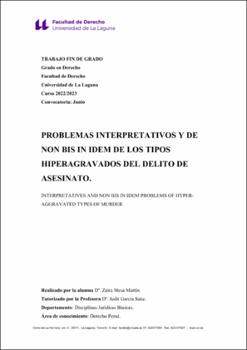Problemas interpretativos y de non bis in idem de los tipos hiperagravados del delito de asesinato.
Autor
Mesa Martín, ZairaFecha
2023Resumen
The reform of the Criminal Code operated by L.O. 1/2015, of March 30,
modified the definition of the crime of murder, which now includes cases in
which another is killed to facilitate the commission of another crime or to prevent
it from being discovered and, in addition, introduced hyperaggravated types
which have given rise to a broad doctrinal and jurisprudential discussion on their
interpretation and delimitation with regard to the aggravated type of the crime of
homicide as well as with regard to the problems of bankruptcy and compatibility
with the principle of non bis in idem that they raise.
Among other issues, we will address the delimitation of the hyperaggravated
type of murder when the victim is under sixteen years of age or a person who is
particularly vulnerable due to age, illness or disability in relation to the basic type
of murder with treachery by helplessness of the victim. On the other hand, we
will also analyze the interpretative issues raised by the hyperaggravated type of
murder, because it is subsequent to a crime against sexual freedom that the
perpetrator had committed on the victim and its delimitation with the basic type
of murder to be committed to prevent another crime from being discovered; and
finally, the bankruptcy relations that arise between the crime against sexual
freedom and the attack against life that follows it. La reforma del Código Penal operada por la L.O. 1/2015, de 30 de marzo,
modificó la estructura del delito de asesinato, añadiendo la circunstancia de matar
a otro para facilitar la comisión de otro delito o para evitar que se descubra y,
además, introdujo tipos hiperagravados, que han dado lugar a una amplia
discusión doctrinal y jurisprudencial sobre su interpretación y delimitación con el
tipo agravado del delito de homicidio así como respecto a los problemas
concursales y de compatibilidad con el principio de non bis in idem que suscitan.
Entre otras cuestiones, abordaremos la delimitación del tipo hiperagravado de
asesinato cuando la víctima sea menor de dieciséis años o una persona
especialmente vulnerable por razón de la edad, enfermedad o discapacidad en
relación con el tipo básico de asesinato con alevosía por desvalimiento de la
víctima. Por otro lado, analizaremos también las cuestiones interpretativas que
suscita el tipo hiperagravado de asesinato por ser este subsiguiente a un delito
contra la libertad sexual que el autor hubiera cometido sobre la víctima y su
delimitación con el tipo básico de asesinato por cometerse para evitar que se
descubra otro delito; y finalmente, las relaciones concursales que se planteen
entre el delito contra la libertad sexual y el ataque contra la vida que le subsigue.





